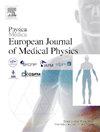Statistical phase alignment of edge spread function for modulation transfer function measurement on computed tomography images
IF 3.3
3区 医学
Q1 RADIOLOGY, NUCLEAR MEDICINE & MEDICAL IMAGING
Physica Medica-European Journal of Medical Physics
Pub Date : 2025-01-01
DOI:10.1016/j.ejmp.2024.104876
引用次数: 0
Abstract
Purpose
This study aimed to develop a statistical approach for edge spread function (ESF) phase alignment to improve the accuracy of modulation transfer function (MTF) measurements at the edges of computed tomography (CT) images.
Methods
A statistical approach to ESF phase alignment was initiated by collecting ESF samples with poor phase alignment. One ESF sample was selected as the reference ESF and the other as the treated ESF. The treated ESF was then shifted by 10-pixels in the right and left directions with a 1-pixel increment at each shift. The mean squared error (MSE) for each shift was calculated between the shifted and reference ESF, and the position with the minimum MSE indicated the best phase alignment between the two ESFs. All shifted ESFs were averaged and differentiated to obtain a single-line spread function (LSF). The MTF was generated by Fourier transformation of the LSF. The MTFs from the shifted ESF and the non-shifted MTF from images of the ACR CT, point-computational, CTDI, and anthropomorphic phantoms were compared.
Results
The MTF curves obtained after the phase alignment showed higher and more consistent results than those obtained before the alignment. The MTF curves obtained after phase alignment were comparable to those obtained from a point computational phantom. Our method showed improved accuracy in measuring spatial resolution compared to those without the edge-shifting method.
Conclusions
The results showed that a statistical approach for ESF phase alignment can overcome poor phase alignment and produce a more accurate MTF curve.
计算机断层扫描图像调制传递函数测量中边缘扩展函数的统计相位对准。
目的:本研究旨在建立一种边缘扩展函数(ESF)相位对准的统计方法,以提高计算机断层扫描(CT)图像边缘调制传递函数(MTF)测量的准确性。方法:通过收集相对准不良的ESF样品,建立ESF相对准的统计方法。选择一个ESF样品作为参考ESF,另一个作为处理ESF。然后将处理过的ESF在左右方向上移动10个像素,每次移动增加1个像素。计算位移后的ESF和参考ESF之间每次位移的均方误差(MSE), MSE最小的位置表示两个ESF之间的最佳相位对准。对所有移位的esf进行平均和微分,得到单线扩展函数(LSF)。MTF由LSF的傅里叶变换生成。比较了ACR CT、点计算、CTDI和拟人模型图像中移位ESF和未移位MTF的MTF。结果:相位对准后得到的MTF曲线比对准前得到的结果更高、更一致。相位对准后得到的MTF曲线与点计算模体得到的MTF曲线相当。与不采用移边法的方法相比,该方法提高了空间分辨率的测量精度。结论:ESF相位对准的统计方法可以克服相位对准不良的问题,得到更准确的MTF曲线。
本文章由计算机程序翻译,如有差异,请以英文原文为准。
求助全文
约1分钟内获得全文
求助全文
来源期刊
CiteScore
6.80
自引率
14.70%
发文量
493
审稿时长
78 days
期刊介绍:
Physica Medica, European Journal of Medical Physics, publishing with Elsevier from 2007, provides an international forum for research and reviews on the following main topics:
Medical Imaging
Radiation Therapy
Radiation Protection
Measuring Systems and Signal Processing
Education and training in Medical Physics
Professional issues in Medical Physics.

 求助内容:
求助内容: 应助结果提醒方式:
应助结果提醒方式:


